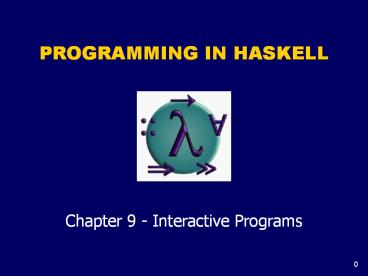Functional Programming - PowerPoint PPT Presentation
Title:
Functional Programming
Description:
... reading from the keyboard and writing to the screen are side effects: ... computer indicates which letters in the secret word occur in the guess. * The game ... – PowerPoint PPT presentation
Number of Views:123
Avg rating:3.0/5.0
Title: Functional Programming
1
PROGRAMMING IN HASKELL
Chapter 9 - Interactive Programs
2
Introduction
To date, we have seen how Haskell can be used to
write batch programs that take all their inputs
at the start and give all their outputs at the
end.
3
However, we would also like to use Haskell to
write interactive programs that read from the
keyboard and write to the screen, as they are
running.
4
The Problem
Haskell programs are pure mathematical functions
- Haskell programs have no side effects.
However, reading from the keyboard and writing to
the screen are side effects
- Interactive programs have side effects.
5
The Solution
Interactive programs can be written in Haskell by
using types to distinguish pure expressions from
impure actions that may involve side effects.
IO a
The type of actions that return a value of type a.
6
For example
The type of actions that return a character.
IO Char
The type of purely side effecting actions that
return no result value.
IO ()
Note
- () is the type of tuples with no components.
7
Basic Actions
The standard library provides a number of
actions, including the following three primitives
- The action getChar reads a character from the
keyboard, echoes it to the screen, and returns
the character as its result value
getChar IO Char
8
- The action putChar c writes the character c to
the screen, and returns no result value
putChar Char ? IO ()
- The action return v simply returns the value v,
without performing any interaction
return a ? IO a
9
Sequencing
A sequence of actions can be combined as a single
composite action using the keyword do. For
example
act IO (Char,Char) act do x ? getChar
getChar y ? getChar
return (x,y)
10
Derived Primitives
- Reading a string from the keyboard
getLine IO String getLine do x ? getChar
if x '\n' then
return else do
xs ? getLine return (xxs)
11
- Writing a string to the screen
putStr String ? IO () putStr
return () putStr (xxs) do putChar x
putStr xs
- Writing a string and moving to a new line
putStrLn String ? IO () putStrLn xs do
putStr xs putChar '\n'
12
Example
We can now define an action that prompts for a
string to be entered and displays its length
strlen IO () strlen do putStr "Enter a
string " xs ? getLine
putStr "The string has " putStr
(show (length xs)) putStrLn "
characters"
13
For example
gt strlen Enter a string abcde The string has 5
characters
Note
- Evaluating an action executes its side effects,
with the final result value being discarded.
14
Hangman
Consider the following version of hangman
- One player secretly types in a word.
- The other player tries to deduce the word, by
entering a sequence of guesses. - For each guess, the computer indicates which
letters in the secret word occur in the guess.
15
- The game ends when the guess is correct.
We adopt a top down approach to implementing
hangman in Haskell, starting as follows
hangman IO () hangman do putStrLn "Think
of a word " word ? sgetLine putStrLn
"Try to guess it" play word
16
The action sgetLine reads a line of text from the
keyboard, echoing each character as a dash
sgetLine IO String sgetLine do x ? getCh
if x '\n' then
do putChar x return
else do putChar '-'
xs ? sgetLine
return (xxs)
17
The action getCh reads a single character from
the keyboard, without echoing it to the screen
import System.IO getCh IO Char getCh
do hSetEcho stdin False
x ? getChar hSetEcho
stdin True return x
18
The function play is the main loop, which
requests and processes guesses until the game
ends.
play String ? IO () play word do
putStr "? " guess ? getLine if guess
word then putStrLn "You got it!"
else do putStrLn (match word guess)
play word
19
The function match indicates which characters in
one string occur in a second string
match String ? String ? String match xs ys
if elem x ys then x else '-' x ? xs
For example
gt match "haskell" "pascal" "-as--ll"
20
Exercise
Implement the game of nim in Haskell, where the
rules of the game are as follows
- The board comprises five rows of stars
1 2 3 4 5
21
- Two players take it turn about to remove one or
more stars from the end of a single row. - The winner is the player who removes the last
star or stars from the board.
Hint Represent the board as a list of five
integers that give the number of stars remaining
on each row. For example, the initial board is
5,4,3,2,1.































